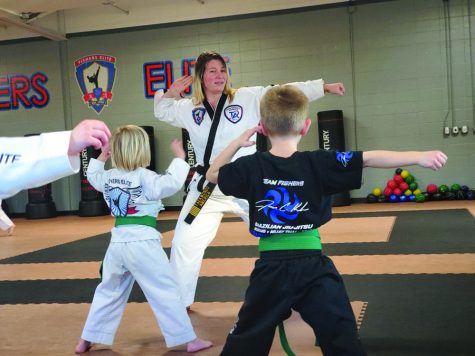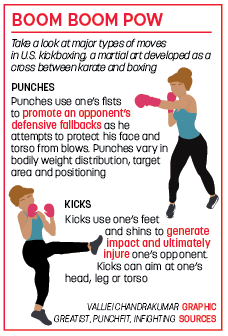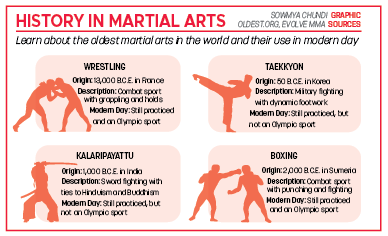Your donation will support the student journalists of Carmel High School - IN. Your contribution will allow us to purchase equipment and cover our annual website hosting costs.
25 years after International Fighting Championship 4, instructors, female martial arts students evaluate female participation in martial arts
January 16, 2021
Sophomore Avery Guo puts on her uniform for the third time this week. She fastens her black belt to her waist, sets her shoes aside and steps into her dojang—a term used in Korean martial arts to refer to a formal training hall—barefoot. She is greeted by her sensei (martial arts instructor) and her fellow students.
Guo said she realized the dojang is the one place she can truly feel comfortable, since she is taught at the dojang how to defend herself if she ever needs to; this is why she began to take martial arts classes in the first place.

“I wanted to learn how to defend myself in a way where I am allowed to be courageous without the constant restrictions in daily life,” she said. “Normally, the stress I accumulate from school dissipates the minute I step into the dojang.”
There are still imperfections, however. Although martial arts instructor Kasi Young of Fishers Elite Martial Arts said she sees pretty much equal male and female enrollment in recent years, Guo said she has noticed her class is mainly composed of male students, and that while she likes the atmosphere of the dojang, she would like to see more female interest in taekwondo and martial arts in general.
Nearly 25 years after the first women were allowed to compete in a martial arts tournament in the United States, female enrollment is still lower than male enrollment. The tournament, called the International Fighting Championship 4, saw the first women competing in martial arts. Since then, there has been a steady road toward equality between male and female participation.
 According to market research company IBISWorld, about 52% of adults who join martial arts clubs in the United States are men. Guo said she wants her female peers to know it isn’t too late to join martial arts.
According to market research company IBISWorld, about 52% of adults who join martial arts clubs in the United States are men. Guo said she wants her female peers to know it isn’t too late to join martial arts.
“I think I’d like to see a larger female class. (Taekwondo) has, personally, really helped me,” Guo said. “I thought it was important to know how to defend myself in a bad situation, something I’ve used to convince some of my female friends to join.”
Kickboxer and freshman Tejasvi Tadikonda said anecdotally she thinks female participation in martial arts probably varies by each martial art, because in kickboxing she has seen a lot of female enrollment.
“Whereas a martial art like taekwondo often has a huge majority in boys, kickboxing has a lot of female enrollment,” Tadikonda said. “That was another reason why kickboxing seemed like a good option (to) me.”
Young said she has also seen more balance between men and women participation in martial arts, another sign of its benefits for its participants.
“Over the years I do believe male and female enrollment has evened out,” Young said. “We have a huge group of girls and women that take classes with us. Fifty percent of our instructors are women. I think women see the benefit of taking class and see it as less of a ‘fighting’ sport.” Click here to read a story about the rise in popularity in mixed martial arts in recent years.

One reason Guo said she continues to practice taekwondo was because of an incident within the school district where martial arts were useful, citing an example of a female student who attended Guo’s taekwondo class and used her martial arts expertise to disarm a potential attacker.
“It was all over the Carmel news,” Guo said. “Just search up ‘Carmel knife attack,’ and you can read about the story. It was basically (an incident) where a girl was attacked but knew how to defend herself because of her taekwondo training. That incident really motivated me to continue taekwondo. You just never really know what is going to happen. This way I had a stress-free mechanism to contribute to my safety insurance.” Click here to read a story on the dangers of spreading rumors on social media, published as a result of this incident.
To teach students how to protect themselves, sensei-in-training Jim Hutchins said martial artists rely on several tactics to escape a bad situation.
“One of the things we teach (are) escape (mechanisms),” Hutchins said. “So if someone grabs (you, you know) how (you are) supposed to get away. One of the escapes we teach is a hair grab. So now my daughter knows that if someone tried to grab her by the hair and drag her around she could escape.”
But martial arts have more positive impacts than just self-defense. According to a study conducted by the UC Berkeley School of Public Health, martial arts can improve balance, strength, endurance and even cognitive capabilities. The study also found that those who participated in martial arts had better mental resilience and attentiveness compared to those not involved.
“In a lot of sports you’ll get really good at one area,” Hutchins said. “If you’re a runner you’ll obviously get very fast, but you might not have a lot of upper body strength. Martial arts are one of the few sports that work (your body) through a whole range of physical motion, flexibility, strength training, stamina, all that kind of stuff.”
 After participating in martial arts, Tadikonda said she found herself to feel fitter, stronger and more content.
After participating in martial arts, Tadikonda said she found herself to feel fitter, stronger and more content.
She said, “What I love about (martial arts) is it really isn’t about the competition or the name-brand sport. It’s more of a fun way to stay healthier and happier.”
Young said there are an array of health benefits, ranging from lessening stress and creating friendships to feeling confident and being fit.
“Martial arts is a mind and body art,” Young said. “It physically keeps you flexible, agile and in good physical health. Martial arts work on cardio, muscle tone and flexibility. The benefits of martial arts and mental health are huge. This is some people’s outlets. They come to class to get away from their stress. The social aspect is also important. We have built a family/community that all bond together and support each other. Martial arts gives people confidence and self-esteem that in the long run will help them in their everyday lives.”
These fitness advantages carry over regardless of age and gender, an easy way for students and people of all types to start an athletic activity without having any background in it.
Tadikonda said she participates in kickboxing because people can join at any age. She said there are fewer age restrictions on learning a martial art compared to sports that are primarily for younger people due to techniques or physical demands that other sports may require.
Hutchins expanded on the age restrictions and said he joined in college but took a greater interest in the art as an adult.

He said, “I think (martial arts) are fantastic in general. (They) give you a lot of good training, in particular physical training. There are a lot of adults at our dojo, and it may be easier to start when you’re younger—as it is with many sports—but martial arts are definitely one of the better sports to pick up.”
IBISWorld found that 63% of martial arts participants are between 18 and 34, compared with 25% who are between 35 and 49 and 11% who are 50 or older. Young, who has been involved with martial arts since she was 10 years old, said she has seen a variety of ages joining.
“I always tell people it is never too late to start,” Young said. “I have people who have started in their 70s. It’s awesome. Martial arts is such an amazing thing for people; it gives them the sense of a team (and) family environment, but you get to move your own individual pace. It’s your own journey.”
For women especially, participating in martial arts can be empowering. Tadikonda said she believes kickboxing is not only a self-defense method or form of fitness but also a way to gain confidence and composure.
“I sort of associate kickboxing with female empowerment,” she said. “I started kickboxing after watching ‘Charlie’s Angels’ and it is a good way to prove I’m as strong as anyone else without having to participate in an organized sport.”
 Guo said she agreed with Tadikonda’s belief that martial arts are an empowerment tool. But Guo said she has felt greater self-assurance through taekwondo than some of her male peers.
Guo said she agreed with Tadikonda’s belief that martial arts are an empowerment tool. But Guo said she has felt greater self-assurance through taekwondo than some of her male peers.
“Taekwondo significantly boosts a girl’s confidence,” Guo said. “It takes someone from feeling vulnerable to feeling confident. That doesn’t mean that it isn’t empowering for men; it just means its impact is to a greater degree for a woman.”
Young also said she agreed.
“I think martial arts help women feel confident and assertive,” Young said. “It will help in self-defense situations. It not only teaches them to physically defend themselves, it helps them develop the ability to have the confidence of de-escalating a situation and trying to avoid a situation that may be harmful to them. I never have been in a fight or in a self-defense situation where I needed to use my martial arts. I credit that to being involved in it.”
A study conducted by the University of Oregon corroborated martial arts’ use as a form of self-defense, showing in most situations women in martial arts were less likely to face violence than women not in martial arts. The study found self-defense to decrease women’s fear and anxiety while increasing their self-assurance.

“Martial arts (have) taught me something I could not get anywhere else,” Young said. “The amount of confidence, humbleness and self-worth I have gotten from this art is incredible.”
From her own experiences, Guo said it has led her to believe in the importance of martial arts for women, whether it was just for the health benefits or for a defense mechanism.
Guo said, “I’d like to see change in the martial arts community. Women should feel like martial arts are an actual choice for them to compete and grow with. I think sometimes martial arts are overlooked because they aren’t as popular in schools, but that doesn’t mean that they should remain underrated.”


